In Richmond’s historic Hollywood Cemetery – in addition to the graves of presidents and Pulitzer Prize winners – is an infamous mausoleum. This tomb – incorporating Ancient Egyptian and Masonic designs and even marked with insignia that look for all the world like fangs – is the resting place of one W.W. Pool, an individual said to have been run out of England for being a vampire. The mausoleum – a notorious gathering place for occultists and those interested in the black arts – isn’t marked with any birth or death date for Pool. There’s just the year 1913 – indicating when his wife died – but no such reference for Pool himself, leading to speculation of an undead vampire inhabiting a gory eternity. Mysteriously, there’s no inscription to tell us anything more about Pool’s life, further heightening local anxieties over the mausoleum’s occupant.
This perplexing and ominous tomb isn’t the only aspect of what’s known as the Richmond Vampire legend. Not far from the graveyard is an old railway tunnel that has long been seen as ‘unlucky’ or ‘cursed’. The Church Hill Tunnel – built in the early 1870s – was notoriously prone to flooding, cave-ins and subsidence, problems so severe that they led to rumours the Richmond Vampire liked to skulk down there, with the evil around the creature generating many of these mishaps. On 2nd October 1925, a disastrous cave-in occurred, with tons of rock and soil crashing down on a work train, killing, trapping and wounding several labourers. Shortly after the catastrophe, eyewitnesses saw a horrific creature running from the tunnel’s end – with fanglike teeth and rolls of decomposing flesh hanging from its body. The creature is said to have sprinted into Richmond’s Hollywood Cemetery and disappeared into the mausoleum of W.W. Pool.
But is this really what happened during the Church Hill Tunnel collapse? Who might the ‘vampire’ who dashed from the tunnel have been? What do we know about the ‘life’ of W.W. Pool before his entombment and how might vampire stories have become attached to him? And what of the reports of ‘occultists’ and ‘Satanists’ gathering around his mausoleum? Let’s begin by examining the strange legend of the Church Hill Tunnel disaster.
A Catastrophic Cave-in in the Church Hill Tunnel and a Hideous Sighting of the Richmond Vampire
The Church Hill Tunnel was built by the Chesapeake and Ohio Railroad company (C & O) in 1873. The 1,200-metre (4,000-foot) tunnel – one of the longest in the US – burrowed 4,000 feet under Richmond’s Church Hill district and was assailed by problems from the start. Richmond’s soft blue marl clay has a tendency to shrink then swell in response to fluctuations in rainfall and groundwater, a fact which – during the tunnel’s construction – led to multiple cave-ins and 10 worker deaths. The tunnel remained so troublesome throughout its working life – with water seepages, safety worries and a tendency to cause buildings on Church Hill to tilt and kink – that in the 1890s a decision was made to replace it with a three-mile, double-track railway viaduct. The viaduct – which extended along the James River, easing past Hollywood Cemetery, Downtown Richmond and Church Hill – was completed in 1901 and in 1902 the tunnel closed.
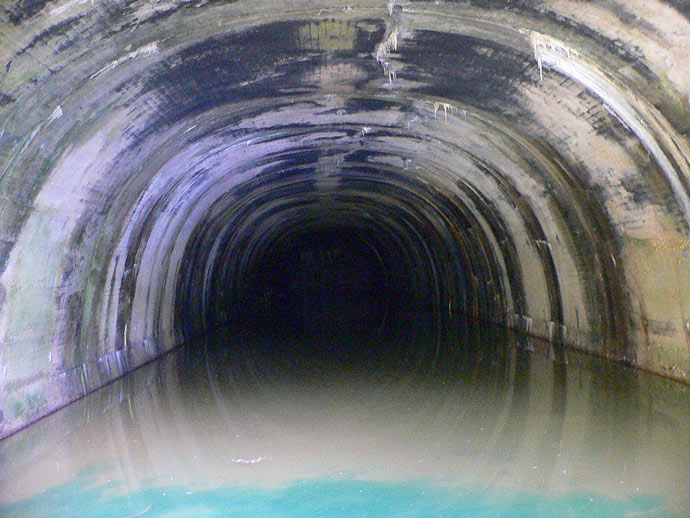
Inside the eastern entrance of the Church Hill Tunnel – was the tunnel a hideout of the Richmond Vampire? (Photo: Jkmscott)
The Church Hill Tunnel, which soon grew dilapidated, stayed shut for over twenty years. But by the 1920s – with Richmond’s population and economy expanding – the C & O realised they needed extra railway capacity so in 1925 the company decided to restore and enlarge the unlucky tunnel. Though every engineering firm consulted thought such plans hairbrained, C & O’s own technicians approved the tunnel as safe and work soon commenced. A series of minor cave-ins, however, took the lives of 12 workers. On October 2nd 1925, a work train and around 200 workmen were in the tunnel, about 160 yards from its western end. Their job was to clear dirt by loading it onto the steam train’s flatcars. As the crew laboured away, a brick fell from the tunnel’s ceiling, slamming onto one of the train’s 10 wagons. The workmen knew this was an ominous signal and, sure enough, more bricks crashed down, severing electrical cables, cutting the lights and plummeting the tunnel into darkness. ‘Watch out, Tom, she’s a-coming!’ Benjamin Mosby – the train’s burly 28-year-old fireman – shouted to his engineer.
Panic buzzed through the black tunnel and workers began swarming towards the exit, stumbling and tripping over railway sleepers and each other, convinced Mosby’s prediction would soon prove accurate. In the mayhem, according to certain accounts, some workers pulled out their knives, slashing desperately at anyone in their way. Suddenly a whole section of the tunnel collapsed. 190 feet’s worth of soil plunged towards the crew, triggering an immense cave-in that spread along most of the tunnel’s length, buckling roads and swaying buildings on the surface. Most of the workmen dived under the train’s flatcars and – crawling beneath them – managed to get out of the tunnel’s eastern end. Shocked labourers poured from the entrance, hobbling with injuries, smeared with dirt and blood, gashed with cuts and gouged with wounds. Then, from among this throng of disorientated workers, there’s alleged to have appeared the most horrendous sight.
A creature staggered into view, spattered with gore and streaked with blood. This entity seemed partially decomposed, with rolls of skin hanging from its naked muscular torso and swollen arms. Fresh blood smeared the creature’s cheeks, neck and mouth, a mouth which hung open to reveal jagged fanglike teeth. Unlike the terrified men around it, the creature showed no indication of shock or concern. Accounts claim the ghoul then dashed in the direction of nearby Hollywood Cemetery. A group of men chased it, but couldn’t catch the fleet-footed monster. They did, however, pursue the creature closely enough to see it disappear into a mausoleum – that of the infamous W.W. Pool.
Some say the pursuers then tried to enter the tomb, but accounts disagree concerning what happened next. One version of the legend has the men jimmying open the door just in time to see a coffin lid closing. Another story insists they found the tomb locked from within and – despite their numbers and strength – were unable to open it. Yet another tale states the vampire screamed curses from inside the mausoleum – presumably so petrifying they caused the men to back off. Ominously, the description of the entity – with folds of skin hanging from its partially decayed flesh – would be consistent with the decomposition expected of a body treated with the burial practices of the time after about two-to-five years. Pool had been placed in his mausoleum three years previously. Some also say that, as the vampire emerged from the tunnel, he muttered something about his wife – and it’s known that Pool shared his mausoleum with his spouse.
Such narratives, unsurprisingly, have led to the notion that the Richmond Vampire was involved in the Church Hill Tunnel disaster. Some believe the vampire, angry at the disruption the engineering works were causing to his underground hangout, caused the tunnel’s collapse. He then gorged himself on the bodies of dead and injured workers, tearing and sucking with his fangs – hence the blood his mouth was smeared with – before fleeing the hazardous tunnel and hotfooting it back to his tomb.
But what really happened during the Church Hill Tunnel catastrophe? Was the apparition seen staggering from the entrance really the Richmond Vampire? Read on and we’ll find out.
What Really Happened with the ‘Richmond Vampire’ and the Church Hill Tunnel Disaster?
A more sober look at the evidence shows the vampire’s appearance during the Church Hill Tunnel disaster in quite a different light. Just before the cave-in, fireman Benjamin Mosby had been shovelling coal into the engine’s furnace. It was common for firemen engaged in such tasks – due to their intense labour and the fire’s heat – to work without a shirt. When the tunnel collapsed, it caused the train’s steam tank to explode. Mosby was struck with a tsunami of steam and scalding water, making his skin peel off in rolls while the force of the explosion flinging him back inflicted further injuries and smashed his teeth.
Mosby, however, managed to escape the engine, crawl beneath the train and stumble out of the tunnel. When he staggered from the entrance, it seems the severe shock he was in made him strangely calm. He asked that his wife be contacted and told he was alive and not to worry. Mosby then collapsed. Workers laid him on a nearby embankment and poured water over him in an attempt to soothe his terrible pain. Bystanders noted that swathes of his blistered skin had fallen away in ‘flaps measuring up to four inches in width’ and that he also had lacerations from crawling under the train and several broken teeth. Mosby was assured his message would be relayed to his wife. A taxi took him to Grace Hospital, where he died within 24 hours.
Interestingly, Mosby was laid to rest in Hollywood Cemetery, though certainly not in W.W. Pool’s mausoleum. Among Richmond working men at the time, apparently, a slang term for dying was ‘going to Hollywood’, a reference to the city’s famous necropolis.
Mosby wasn’t the only fatality the Church Hill Tunnel cave-in caused. Though Mosby was the only man who made it out of the tunnel to have died, others weren’t able to escape. The duty roster listed three men, including the train’s engineer – one Thomas Joseph Mason – as missing. In an attempt to find any lingering survivors or recover bodies, C & O dug down from the surface, getting to the train eight days after the collapse. They reached Mason’s cabin – his corpse was found upright in his chair, pinned into place by the engine’s reverse lever. At that point, the company chose not to go on with the rescue effort, citing the cost ($30,000 dollars in modern money) and the fact the rescue attempts had triggered more cave-ins. Their decision may have also been influenced by the fact that the other two missing men – Richard Lewis and H. Smith – were African-American casual labourers. There may well have been more itinerant workers – some have speculated as many as six – trapped in the Church Hill Tunnel as record keeping of such people in those days could be scanty. Whoever was left was destined be entombed in there, along with the locomotive and its 10 flatcars. In spring 1926, the Virginia State Corporation Commission, which regulated the state’s railroads, ordered the tunnel’s western end sealed for safety reasons.
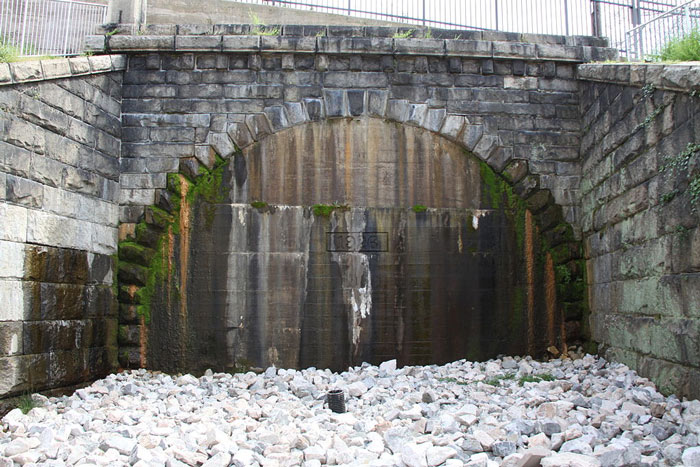
The sealed western end of Richmond’s Church Hill Tunnel. (Photo: Eli Christman)
So it seems the part of the Richmond Vampire legend centred on the Church Hill Tunnel was based on the death of Benjamin Mosby. The skin hanging from the body, the blood, the ‘fangs’, and even the vampire’s apparent ‘calm’ and utterance about his wife all chime with Mr Mosby’s horrendous experience. Though newspaper reports of the accident at the time seem to have been factual – the taxi that took Mosby to hospital had just carried a journalist to the scene – it’s likely that over the years memories of the incident became distorted into something even more sinister. The fact Mosby was buried in Hollywood Cemetery and the workers’ slang phrase ‘going to Hollywood’ might have later fed into an evolving belief linking the ‘vampire’ that emerged from the tunnel with that graveyard. The vampire’s dash for the necropolis may be a garbled retelling of some accounts that claimed Mosby at one point tried to run towards the James River.
But what of the myth’s other component – W.W. Pool, his alleged vampirism and his creepy mausoleum in Hollywood Cemetery? Let’s see what we can find out about this elusive character.
Was W.W. Pool the Richmond Vampire?
Legend states that W.W. Pool was run out of England for vampirism, but it appears Pool was born in Mississippi around 1847. William Wortham Pool was the son of Samuel Pool, a merchant, and by 1860 William was employed as a clerk in the state capital, Jackson. Later in the 1860s, Pool moved to Virginia, working as a clerk in a tobacco factory in the Richmond suburb of Manchester then as a bookkeeper and private secretary. He became a well-established Richmond accountant, often working for the influential Bryans, a family of newspaper publishers. Pool married his wife Alice in 1866 and they had four children. His wife passed away in 1913, but Pool lived on until the age of 75, dying of pneumonia in February 1922. The only mildly spooky incident connected with Pool’s death was the fact his close friend, one Samuel Owens, died on the same day. Owens – Manchester’s commissioner of revenue – had, along with Pool, been a prominent member of Richmond’s Central Methodist Church and had attended the same Freemasons’ lodge. Active in civic affairs, Pool appears to have been a person of some local influence in his later life. Shortly after his death, he was described as ‘one of the oldest and most widely known residents of South Richmond’.
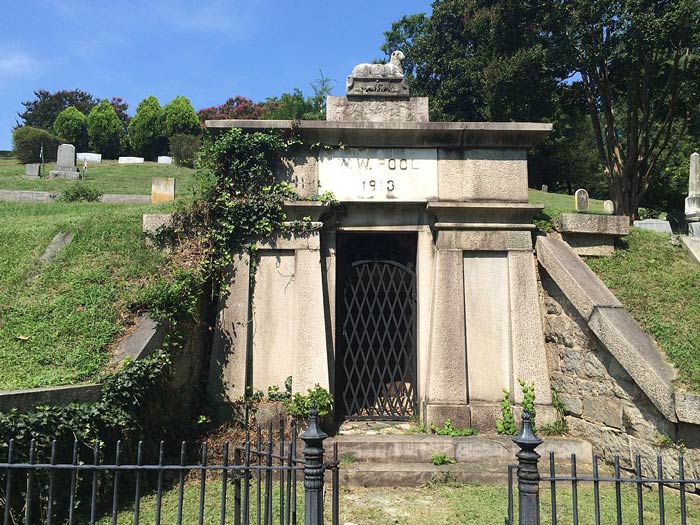
The mausoleum of W.W. Pool in Hollywood Cemetery, Richmond, Virginia – the tomb of the Richmond Vampire? (Photo: RVA all day)
So how did the outlandish Richmond Vampire legend come to weave itself around W.W. Pool, a man who appears to have led an exceptionally normal and respectable, if moderately successful, life? It’s possible that the seeds of some of the rumours were planted thanks to the elaborate funerals of Pool and Owens, funerals which included full Masonic rites. The Richmond News Leader reported: ‘Today is a virtual holiday in this section (Southside) of the city, owing to the funeral services of W.W. Pool and Samuel R. Owens, two of the most distinguished citizens of Southside. Representatives from practically all the public offices, hustings court and banks and persons from all walks of life attended the funeral of Mr Pool this morning … and the same large crowd will pay the last tribute of respect to Mr Owens this afternoon.’
Most of the vampire hysteria around Pool is, however, likely to have come from his tomb. The mausoleum’s only inscriptions are the name ‘W.W. Pool’ and the year 1913. There was a biblical quote – Isiah 11:6 – ending with the phrase ‘and a little child shall lead them’, but the slab bearing this inscription fell off a few years ago. There’s been speculation that the W’s resemble fangs, that the lack of a clear birth and death date suggests Pool is immortal, and that the ‘child’ referred to in the Isiah quote is either a small vampire or one of the ‘children of the night’. Anyone with a little historical knowledge could explain such things away. Tombs of the time often lacked birth and death dates, elaborate inscriptions or even names – part of the sense of thriftiness Pool’s generation was known for. (Unnecessary words would mean paying the stone mason extra.) Pool had the tomb constructed for his wife, hence it being chiselled with the year of her death, and seems to have left no instructions to add any more engravings when he was placed within. The Isiah quote was likely just inspired by Pool’s Methodist beliefs and the observation the W’s resemble fangs is just too silly to have much comment expended upon it.
There is, though, perhaps something eerie about Pool’s mausoleum with its Neo-Egyptian design, something that makes it stand out in a cemetery where the more conspicuous tombs tend to have Greco-Roman influences. Nods to Ancient Egypt do make people think of things spooky, mummified and magical and of the questing for immortality. (The presence of a large pyramid, unconnected to Pool, in the centre of Hollywood Cemetery has likely also added to this mysterious ambiance.) The Egyptian design of Pool’s tomb was probably inspired by nothing more than the widespread interest in Ancient Egyptian archaeological finds in the 19th and early 20th centuries, an interest perhaps made more intense in Pool’s case by his Masonic leanings. One intriguing legend the Pool mausoleum has generated, however, is that the signatures on the tomb’s land records – first inscribed by Pool then by others – are all in exactly the same handwriting.
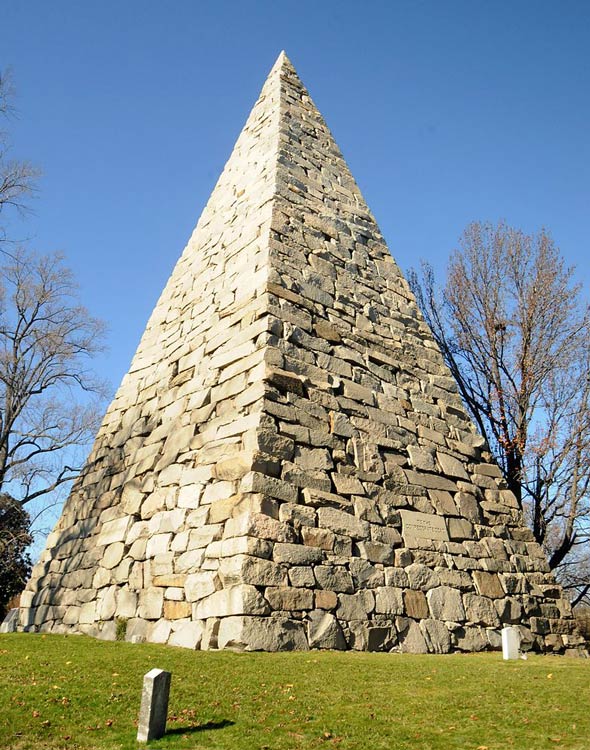
Pyramid commemorating Confederate soldiers killed in the Civil War in Hollywood Cemetery, Richmond, Virginia. (Photo: David Broad)
But when might the legends around W.W. Pool’s tomb have arisen, what factors might have influenced them, and what of the sinister reports of occultists and Satanists congregating around Pool’s resting place? Let’s investigate below.
What Could Explain the Strange Rumours of the ‘Richmond Vampire’ and the ‘Occult Activities’ around the Tomb of W.W. Pool?
Spooky historic cemeteries do have a tendency to generate vampire legends. A famous outbreak of vampire hysteria occurred around London’s Highgate Cemetery in the 1970s while in the 1950s hundreds of youngsters invaded Glasgow’s Southern Necropolis searching for a child-eating vampire who’d apparently taken up residence there. It’s also interesting that the Richmond Vampire legend is linked to the dangerous working conditions of the Church Hill Tunnel. Hazardous and unpleasant working environments can give rise to a strange brand of industrial folklore. Glasgow’s vampire rumpus was connected with a steelworks that sparked and smoked just behind the necropolis and tough conditions at Pittsburgh steel mills helped create the myth of Joe Magarac, a giant superhuman steelworker who stirred vats of molten metal with his hands and rescued workmates from industrial accidents.
But, with regards to the Richmond Vampire, perhaps an institution lying close to Hollywood Cemetery was responsible for much of that legend’s fame. The graveyard is adjacent to Virginia Commonwealth University (VCU) and the idea a vampire slept in the necropolis seems to have spread among the students in the late 1950s and 1960s. Stories circulated of strange occurrences in the cemetery, especially after night-time adventures spent sneaking into the graveyard. Such stories were likely fuelled by that period’s vogue for horror films and the appearance of various kinds of undead creatures on late-night TV. (And many who were students in the 1960s would have grown up watching 1950s vampire movies.) As the 1960s wore on, the over-active imaginations of some undergraduates may have also been enhanced by the psychedelics widely consumed in that era. The Richmond Vampire myth established, it seems to have been handed down to new generations of students over the decades.
The tendencies of VCU students to creep into Hollywood Cemetery to visit the tomb of W.W. Pool may reflect a phenomenon known as ‘legend tripping’. ‘Legend tripping’ is a kind of rite of passage in which – usually young – people visit sites associated with supernatural or traumatic events. Such sites might include tunnels, ‘haunted houses’, the locations of accidents, and – most commonly – graveyards. These visits give youngsters a chance to prove their courage in front of their friends, to gain a sense of adventure and to feel they are – at least temporarily – flouting adult rules and norms. A widespread example of legend tripping in the United States centres on graveyard seats and benches. Legends claim those sitting on these ‘Devil’s chairs’ at certain times, such as midnight or Halloween, will invite death or curses upon themselves or even get to see or speak to the Evil One. In the case of the Richmond Vampire, it’s easy to see how excitable students – minds swarming with horror movie images and perhaps buzzing with LSD – might have enhanced, popularised or even invented that myth. It’s possible that legends of the Richmond Vampire were around before VCU students became obsessed with the creature, but the first known mention in print of the Richmond Vampire story doesn’t appear until 1976 – in VCU’s Commonwealth Times newspaper.
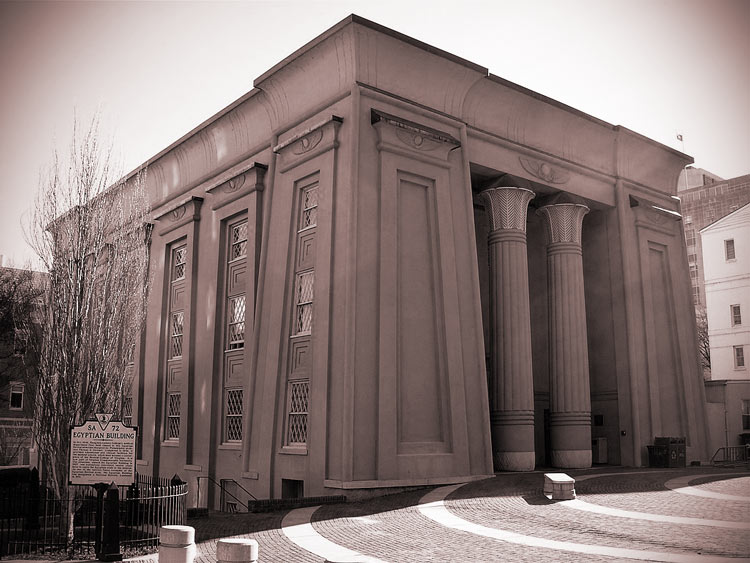
Virginia Commonwealth University’s Egyptian Building – did this institution’s students amplify the Richmond Vampire legend? (Photo: Crazyale)
But what, we might ask, of the component of the legend dealing with the Church Hill Tunnel collapse? The collapse occurred in 1925 so – even though the ‘vampire’ was just the unfortunate Benjamin Mosby – wouldn’t this give the Richmond Vampire legend an earlier origin? Some argue, however, that the tales of the Church Hill Tunnel disaster and the ‘vampiric’ W.W. Pool were not combined until quite recently. The first known text that weaved together these two narratives didn’t appear until 2001, online. Since then, numerous articles and blogposts have combined the two stories and their amalgamation received a boost in 2007 with the publication of the book Haunted Richmond: The Shadows of Shockoe. This book is the first known example of the meshing of these two stories in print. It is, of course, possible that oral folklore had merged the two narratives earlier, but there’s no firm evidence this was the case.
Whatever the roots of the Richmond Vampire legend, the myth has certainly inflamed the public imagination. Hollywood Cemetery staff have reported that kids and tourists appear regularly at their office asking earnestly if there’s a vampire in the graveyard. More disturbingly, there have been accounts of occult activity around W.W. Pool’s mausoleum. In the 1980s, the tomb’s door was prised open and ‘occult words and symbols’ were scrawled on the walls. Fetishes are frequently left by the mausoleum’s gates. Hollywood Cemetery officials even took the decision to move the remains of Pool and his wife from the tomb as people were allegedly stealing parts of their bodies.
Others, though, doubt that serious Satanists and occultists have been congregating at Pool’s mausoleum. The Richmond paranormal investigation group Night Shift wrote, ‘The story of occultists visiting the crypt every Halloween is not likely … the cemetery in Richmond, Virginia, is known to have a better than common security staff. If they visited on any kind of timetable, they would most certainly be apprehended … our experience with occult groups indicates that they rely heavily on ritual. This casts doubt on the theory of randomised visits … making it a more likely target of young college students proving their nocturnal machismo to their friends.’
College students may even be to blame for the thefts of bits of Pool’s body. The 1976 Commonwealth Times article stated, ‘Mr Pool is an alleged vampire. There seems to be a cult in Richmond that has grown up around him. I find this strange since I’ve heard that it used to be the ‘in’ thing among medical students to break in and steal parts of his remains.’
So it seems that Pool’s now dilapidated mausoleum never housed a vampire, that it no longer even houses Pool’s corpse, and that the ‘Satanists’ drawn to the tomb may be simply over-excited college students. Hollywood Cemetery is still, however, worth a visit. Its 130 bucolic tree-filled acres contain the tombs of two US presidents – James Monroe and John Tyler – as well as the grave of Confederacy president Jefferson Davis. There’s also the resting place of a teacher of Edgar Allan Poe – who hailed from Richmond – as well as the tombs of a couple of Pulitzer Prize winners. A 90-foot stone pyramid commemorates over 18,000 confederate soldiers buried in the cemetery. But anyone searching for a genuinely spooky experience in connection with the Richmond Vampire legend might be better advised to stray closer (but not too close) to the old Church Hill Tunnel.
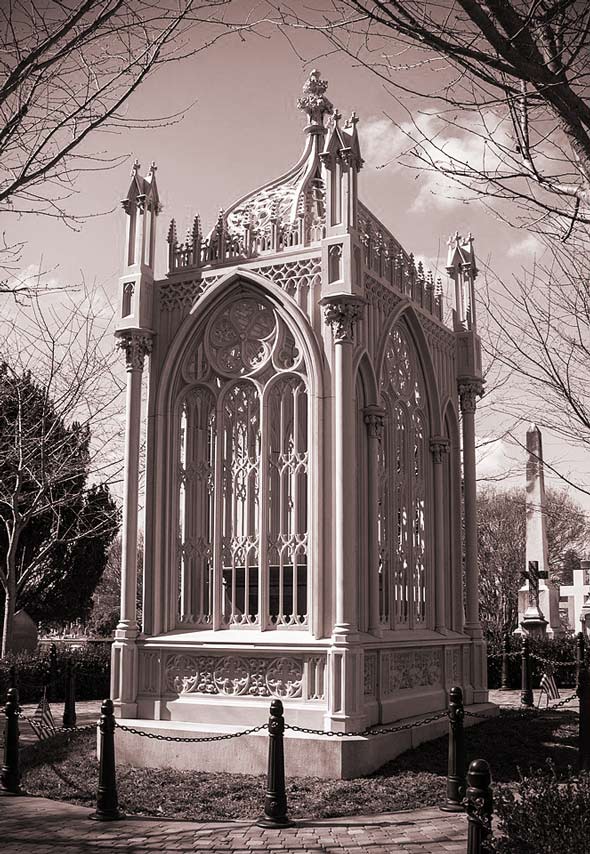
The neo-gothic tomb of President James Monroe in Hollywood Cemetery, Richmond, Virginia. (Photo: ɱ)
The tunnel’s western entrance – plugged with concrete – stands close to the corner of 18th and Marshall Street. Though the eastern end is theoretically accessible, it’s in a state of dangerous disrepair. Surrounded by a small swampy jungle, the eastern mouth beckons ominously near the intersection of E. Franklin Street and N. 31st. Over the years, more portions of the tunnel have collapsed, with one of the largest cave-ins causing mayhem above, demolishing several houses and a church wall. Dips can be discerned in some streets that cross the tunnel’s path. The parts of the tunnel that haven’t caved in contain high water levels and a gritty, quicksand-like silt, making exploration hazardous.
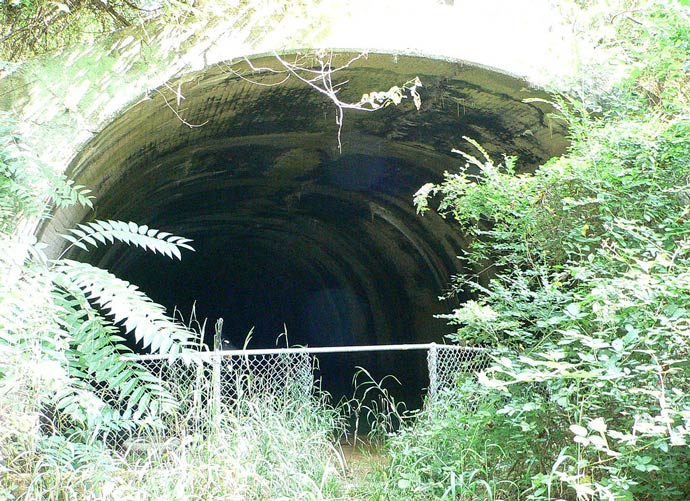
The eastern entrance of the Church Hill Tunnel, Richmond, Virginia. (Photo: Jkmscott)
In June 2006, the Virginia Historical Society and other organisations, including the History Channel, announced an intention to recover the train – which they planned to preserve – as well as any bodies the tunnel held. They were, however, forced to put this project off until ways could be found to shore up the tunnel against further collapses. There was also the possibility that disturbing the Richmond Vampire’s old lair could lead to houses on Church Hill being swallowed by enormous sinkholes.
Whether or not the tunnel is ever opened again, people walking near it have claimed to hear disturbing noises: digging sounds, screams of ‘Get me out! Get me out!’ and even the screech of locomotive wheels.
(This article’s main image, showing the tomb of the alleged Richmond Vampire W.W. Pool, is courtesy of RVA all day.)
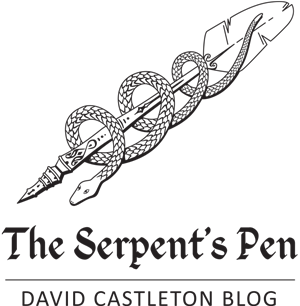
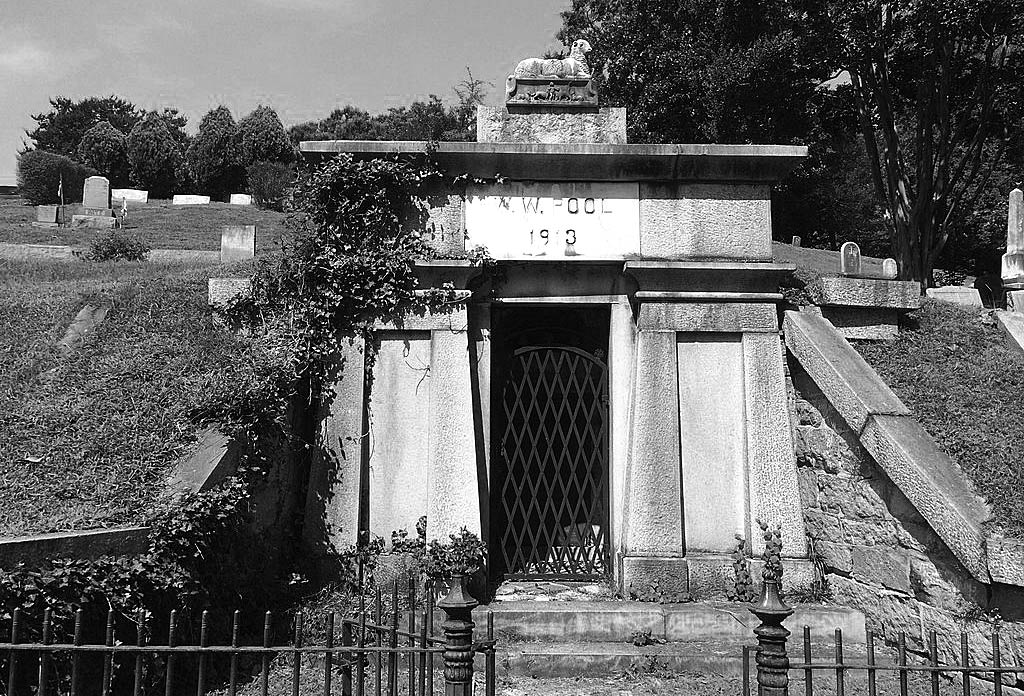
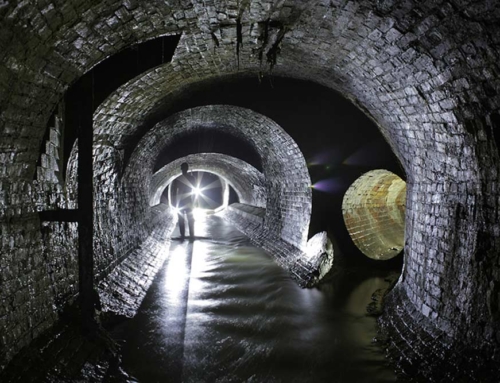
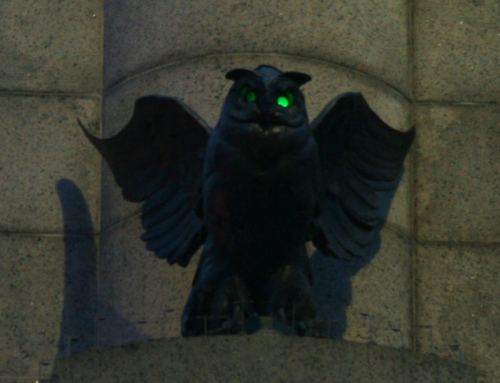
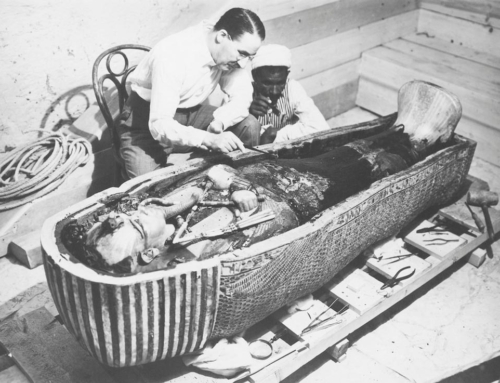
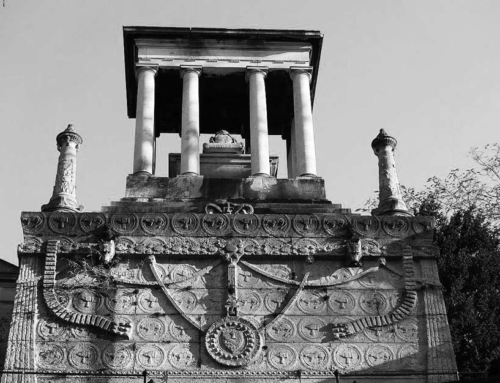
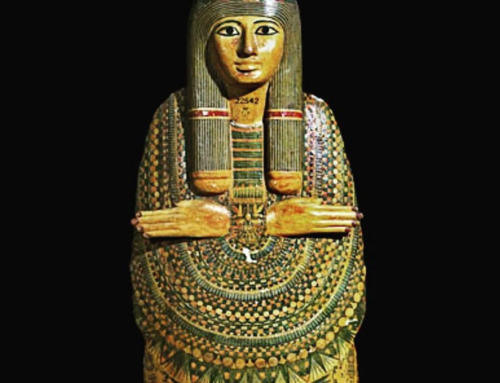
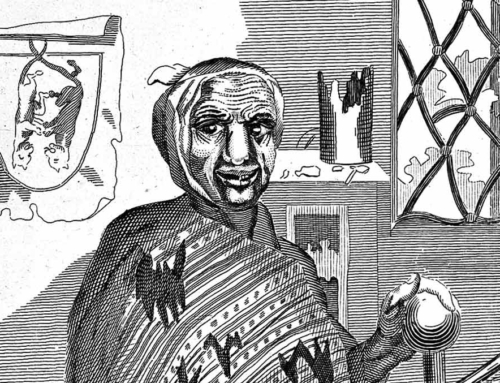
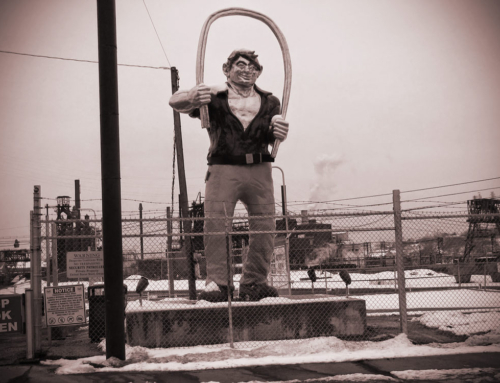
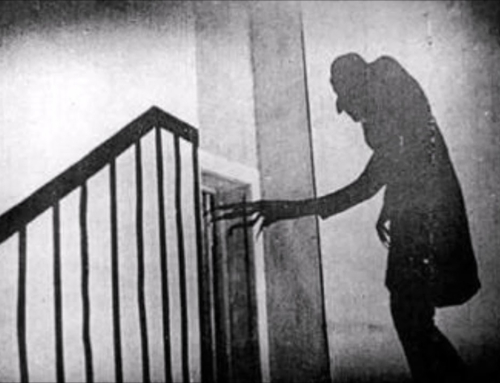
Really enjoyed this – so well researched!
Many thanks, Carole, glad you enjoyed the tale of the Richmond Vampire!
This was so well wrote I definitely hope to make a visit there someday. I love historical sites
Thanks, Judi, glad you enjoyed the article.